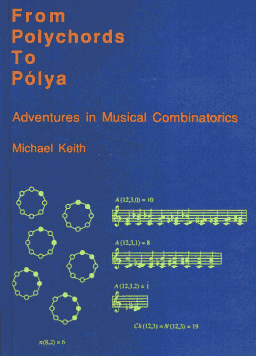From Polychords to Polya: Adventures in Musical Combinatorics
by Mike Keith
From the time of Pythagoras, who
realized that the difficulty in constructing a musical scale
is due to the fact that there are no integer solutions to the
equation
(3/2)m = 2n,
until the present time, when computer algorithms are used
to compose musical pieces, there has been a lively
interaction between the musical arts and the mathematical
sciences.
This book explores the various
connections between the basic musical building blocks -
chords, scales, and rhythms - and the area of mathematics
known as combinatorics, which is concerned with counting and
classifying configurations of objects. We consider questions
such as the following:
- How many essentially different musical chords are
there?
- How many different scales are there? How many of
certain types, such as 7-note diatonic?
- How many different rhythms can be constructed?
- Why are certain chords, scales and rhythms more
prevalent than others in popular music?
In the process of examining these
questions we find applications of many mathematical concepts:
binomial coefficients, necklace counting, Pascal's triangle,
the Fibonacci sequence, and Polya counting theory. Even the
Catalan numbers make a brief appearance.
FPTP (as we like to call it) was first published
in 1991 but is now out of print. However, a scan of the full book in
PDF format is available
here.

